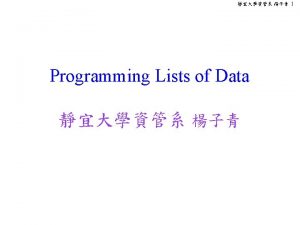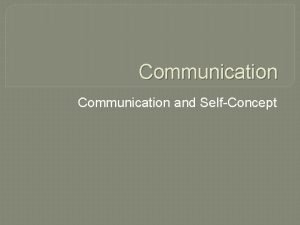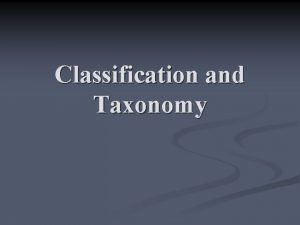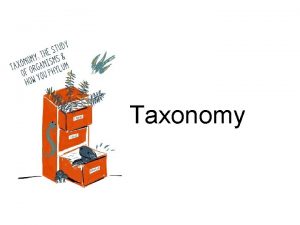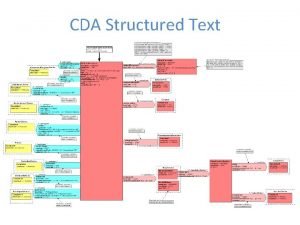Aim To develop a taxonomy hierarchically structured list



























- Slides: 27

Aim To develop a taxonomy (hierarchically structured list) of BCTs that is useful to intervention researchers and designers across disciplines, health domains and countries 3

Published Protocol 4

This Talk 1. Background 2. Developing the Taxonomy 3. Next steps 5

Background • Problem of imprecise reporting of behaviour change (BC) interventions – Interventions typically complex – No agreed framework for describing active ingredients of behavior change techniques • Calls for improved methods of specifying intervention content • Address this by developing taxonomies of behaviour change techniques (BCTs) 6

Definition of a BCT a) aims to change behaviour b) is the proposed "active ingredient" of interventions c) is the smallest component compatible with retaining the proposed active ingredients d) can be used alone or in combination with other BCTs e) is observable and replicable f) can have a measurable effect on a specified behaviour g) is the smallest unit that has the POTENTIAL (in the right circumstances) to bring about behaviour 7 change

Example of a Reliable Taxonomy: to change physical activity and healthy eating behaviours Involves detailed 15. planning of what the person will do General encouragement 1. General information including, at least, a very specific definition of the behaviour 16. Contingent rewards 2. Information on consequences e. g. , frequency (such as how many times a day/week), 17. Teach to use intensity (e. g. , speed) or duration (e. g. , cues for how long for). In 3. Information about approval addition, at least 18. one Follow of the following contexts i. e. , where, up prompts 4. Prompt intention formation when, how or with whom must be specified. 19. Social comparison 5. Specific goal setting 20. Social support/ change 6. Graded tasks 21. Role model 7. Barrier identification 22. Prompt self talk 8. Behavioral contract 23. Relapse prevention 9. Review goals 24. Stress management 10. Provide instruction The person is asked to keep a 25. Motivational interviewing 11. Model/ demonstrate record of specified behaviour/s. 26. Time management 12. Prompt practice This could e. g. take the form of a 13. Prompt monitoring diary or completing a 14. Provide feedback questionnaire about their behaviour. Inter-rater agreement of 85 -100% (Abraham and Michie, 2008) 8

Further Taxonomies • Smoking cessation: 53 BCTs Michie et al, Annals of Behavioral Medicine, 2010; Addictive Behaviors, 2011 • Physical activity & healthy eating: 40 BCTs Michie et al, Psychology & Health, 2011 • Reducing excessive alcohol use: 42 BCTs Under review • General behaviour change: 137 BCTs Michie et al, Applied Psychology: An International Review, 2008 9 9

Development of BCT Taxonomy Stage 1: Online Delphi Consensus Exercise Stage 2: Stage 3: Pilot coding Feedback from International Advisory Board (IAB) 10

Development of BCT Taxonomy Stage 1: Online Delphi Consensus Exercise Stage 2: Stage 3: Pilot Coding Feedback from International Advisory Board (IAB) 11

Participants (n=14) • Self reported expertise in delivering and/or designing behaviour change interventions • Aged 37 -62 (M = 51; SD = 8) • From five countries UK; Australia; Netherlands; Canada and New Zealand • From a range of disciplines 6 health psychologists; 1 clinical psychologist; 3 clinical & health psychologists; 1 educational psychologist; 1 cognitive behaviour therapist; 1 health sciences expert; 1 community health expert. 12

Procedure 1. Synthesise existing taxonomies (94 BCTs) 2. Delphi consensus exercise (Round 1) 3. 1 st refinement of taxonomy 4. Delphi consensus exercise (Round 2) 5. 2 nd refinement of taxonomy 13

Delphi Survey Questions (Round 1) 1. Active ingredient? [1 ‘definitely yes’ - 5 ‘definitely no’] 2. conceptually unique/redundant/overlapping [forced choice] 3. If redundant please state why … 14

4. If overlapping, a) with which BCT(s)? b) Can they be separated? c) If separable, how could the label or definition be rephrased to reduce the overlap? d) If duplicates which label and which definition was better? 5. unnecessary characteristics and/or omitted characteristics? 15

1 st Refinement of Taxonomy • On basis of responses – numerical ratings and qualitative feedback, labels and definitions amended 16

Delphi Survey Questions (Round 2) 1. a) clear b) precise c) distinct? 2. Would you feel confident in using this BCT to describe the intervention? 3. Would you feel confident that two behaviour change researchers or practitioners would agree in identifying this BCT? 17

Results of Delphi Exercise 94 BCTs 16 omitted; 4 split into two; 2 added 35 definitions and 7 labels amended Post Delphi: 84 BCTs 18

Development of BCT Taxonomy Stage 1: Online Delphi Consensus Exercise Stage 2: Stage 3: Pilot Coding Feedback from International Advisory Board (IAB) 19

Stage 2: Pilot Coding • 6 experts coded 45 transcripts of published reports of BC interventions • Each intervention was coded independently by a pair of experts • Inter-rater agreement calculated, discrepancies noted, synthesised and source of disagreement identified. 20

Stage 2: Pilot Coding • 3 Sources of disagreement: - Differing interpretations of labels and definition - Overlooked BCTs - Misapplication of general coding principles 21

Development of BCT Taxonomy Stage 1: Online Delphi Consensus Exercise Stage 2: Stage 3: Pilot Coding Feedback from International Advisory Board (IAB) 22

Stage 3: Feedback from International Advisory Board • Arja Aro • Paul Glasziou • Miquel Porta • David Barlow • Gaston Godin • Tony Roth • Christine Barrowclough • Jeremy Grimshaw • Rob Sanson-Fischer • Ron Borland • Nick Heather • Neil Schneiderman • Belinda Borrelli International • Blair Johnson • Ralf Schwarzer Advisory Board • Linda Collins • Robert Kaplan • Bonnie Spring • Karina Davidson • Francis Keefe • Nick Tarrier • Joost Dekker • Gerjo Kok • Antti Uutela • Hege Erikson • Helen Lindner • Reinout Wiers • Jeff Fisher • Steve Pilling • Redford Williams 23

Stage 3: IAB Feedback • 30 members asked to provide feedback on the post Delphi taxonomy • General and specific feedback requested 24

Stage 3: Feedback from IAB Members (n = 16) • Recommended grouping BCTs to enhance usability Online sort task Experts Needed!!! 25

Development of BCT Taxonomy Stage 1: Online Delphi Consensus Exercise Stage 2: Stage 3: Pilot Coding Feedback from International Advisory Board (IAB) 26

3 rd Refinement of Taxonomy Following Coding and IAB feedback Post Delphi: 84 BCTs 5 BCTs added 30 definitions and 15 labels amended Post stage 2 & 3 : 89 BCTs 27

Next Steps… Phase 2: Evaluate the taxonomy 1. Training coders to code published intervention reports: assess reliability 2. Using taxonomy to design interventions: assess added value re. clarity and replicability Phase 3: Disseminate the prototype taxonomy 1. Create a web-based users resource and basis for further development, guided by an international consortium 28

For More Information … Email BCTTaxonomy@ucl. ac. uk Michie et al (2011) Implementation Science http: //www. ucl. ac. uk/health-psychology/BCTtaxonomy 29
 Hierarchically
Hierarchically Disadvantages of unstructured interviews
Disadvantages of unstructured interviews Sa sd
Sa sd Kendall's and marzano's new taxonomy verbs
Kendall's and marzano's new taxonomy verbs Aim words list
Aim words list What are the undefined terms in the axiomatic system
What are the undefined terms in the axiomatic system Singly vs doubly linked list
Singly vs doubly linked list Introduction to linked list
Introduction to linked list List g shows list of
List g shows list of Fungsi linked list
Fungsi linked list Select list item list index too large
Select list item list index too large Why did a stale- mate develop on the western front?
Why did a stale- mate develop on the western front? Why did a stale- mate develop on the western front?
Why did a stale- mate develop on the western front? Competency based job description sample
Competency based job description sample Massive igneous rocks
Massive igneous rocks Intrapersonal skills
Intrapersonal skills Approaches to develop social factors
Approaches to develop social factors Develop schedule in project management
Develop schedule in project management Alarm clock use case diagram
Alarm clock use case diagram Jeanette tetrault
Jeanette tetrault Develop discrepancy example
Develop discrepancy example Hamlet's dull revenge summary
Hamlet's dull revenge summary Timeline of counseling in the philippines
Timeline of counseling in the philippines Retrospective goals in conflict
Retrospective goals in conflict Food product knowledge
Food product knowledge Master data management strategy roadmap
Master data management strategy roadmap Reflected appraisal
Reflected appraisal Valstm
Valstm










